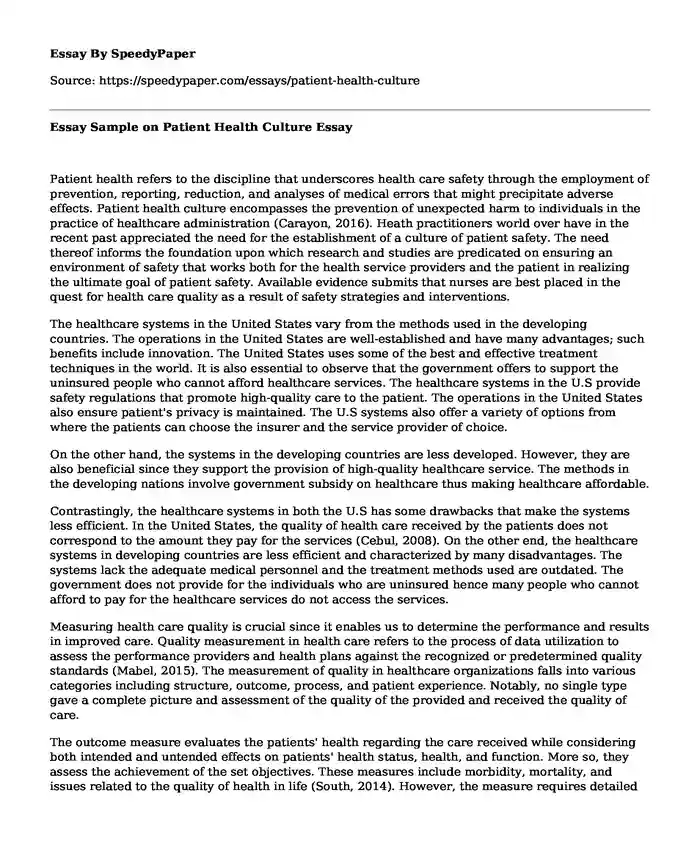
| Type of paper: | Research paper |
| Categories: | Culture Healthcare |
| Pages: | 3 |
| Wordcount: | 669 words |
Patient health refers to the discipline that underscores health care safety through the employment of prevention, reporting, reduction, and analyses of medical errors that might precipitate adverse effects. Patient health culture encompasses the prevention of unexpected harm to individuals in the practice of healthcare administration (Carayon, 2016). Heath practitioners world over have in the recent past appreciated the need for the establishment of a culture of patient safety. The need thereof informs the foundation upon which research and studies are predicated on ensuring an environment of safety that works both for the health service providers and the patient in realizing the ultimate goal of patient safety. Available evidence submits that nurses are best placed in the quest for health care quality as a result of safety strategies and interventions.
The healthcare systems in the United States vary from the methods used in the developing countries. The operations in the United States are well-established and have many advantages; such benefits include innovation. The United States uses some of the best and effective treatment techniques in the world. It is also essential to observe that the government offers to support the uninsured people who cannot afford healthcare services. The healthcare systems in the U.S provide safety regulations that promote high-quality care to the patient. The operations in the United States also ensure patient's privacy is maintained. The U.S systems also offer a variety of options from where the patients can choose the insurer and the service provider of choice.
On the other hand, the systems in the developing countries are less developed. However, they are also beneficial since they support the provision of high-quality healthcare service. The methods in the developing nations involve government subsidy on healthcare thus making healthcare affordable.
Contrastingly, the healthcare systems in both the U.S has some drawbacks that make the systems less efficient. In the United States, the quality of health care received by the patients does not correspond to the amount they pay for the services (Cebul, 2008). On the other end, the healthcare systems in developing countries are less efficient and characterized by many disadvantages. The systems lack the adequate medical personnel and the treatment methods used are outdated. The government does not provide for the individuals who are uninsured hence many people who cannot afford to pay for the healthcare services do not access the services.
Measuring health care quality is crucial since it enables us to determine the performance and results in improved care. Quality measurement in health care refers to the process of data utilization to assess the performance providers and health plans against the recognized or predetermined quality standards (Mabel, 2015). The measurement of quality in healthcare organizations falls into various categories including structure, outcome, process, and patient experience. Notably, no single type gave a complete picture and assessment of the quality of the provided and received the quality of care.
The outcome measure evaluates the patients' health regarding the care received while considering both intended and untended effects on patients' health status, health, and function. More so, they assess the achievement of the set objectives. These measures include morbidity, mortality, and issues related to the quality of health in life (South, 2014). However, the measure requires detailed information only available to medical records which are difficult and quite expensive to obtain. Differences in the population of the patients achieve the outcome difficult which is also another challenge. Finally, the patient experience measure gives feedback on the patient's experience of provided care including their interpersonal or social aspects of care.
References
Carayon, P. (Ed.). (2016). Handbook of human factors and ergonomics in healthcare and patient safety. CRC Press.
Cebul, R. D., Rebitzer, J. B., Taylor, L. J., & Votruba, M. E. (2008). Organizational fragmentation and care quality in the US healthcare system. Journal of Economic Perspectives, 22(4), 93-113.
Mabel, E. (2015). Community health nursing advocacy: A concept analysis, Community health nursing advocacy 32(2):115-28.
South, J., (2014). Health promotion by communities and in communities: Current issues for research and practice. Scandinavian Journal of Public Health, 42 (15), 82-87.
Cite this page
Essay Sample on Patient Health Culture. (2022, Aug 01). Retrieved from https://speedypaper.net/essays/patient-health-culture
Request Removal
If you are the original author of this essay and no longer wish to have it published on the SpeedyPaper website, please click below to request its removal:
- Childhood Obesity Essay Example
- Research Paper Sample on Using Songs for Teaching English
- Free Essay on Orem's Model and Diet in Obese Patients with DMtype 2
- The Poem of Imru Ul Qais, Free Essay in Literature
- Free Paper: CV Example of a Public Relations Manager
- Essay Sample for You, Access to Health Care: Moral Right or a Privilege
- COVID-19: Impact on World Economic Development & 24.9M Cases - Essay Sample
Popular categories




